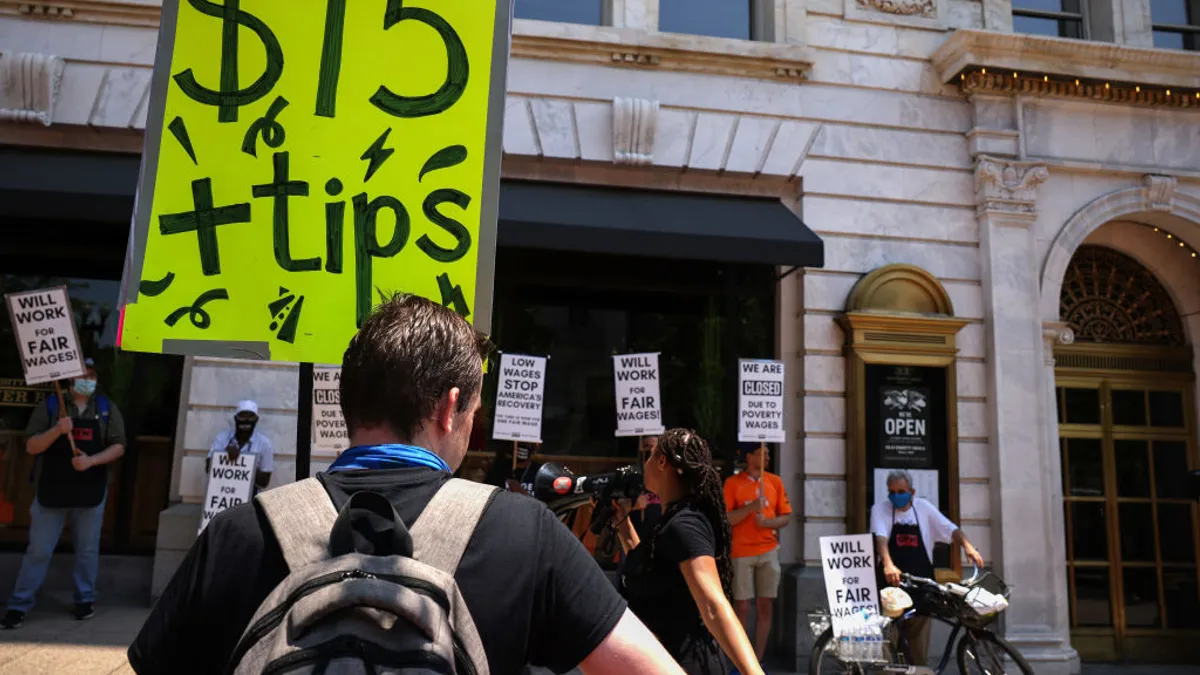The minimum wage has long been a source of debate among workers, business owners and governments. In the last few years, some cities and states have raised their minimum wage to $15 an hour—a number that in many places still isn’t enough for people to get by, researchers say.
Before the fight for $15, cities had living wage ordinances. Rather than increasing pay for everyone, these ordinances only do so for certain workers, typically those at businesses that contract with or receive assistance from local government.
Burlington, Vermont, adopted a living wage ordinance in 2001 as part of a wave of cities taking that action. The ordinance in Vermont’s most populous city applies to any employer that gets paid at least $15,000 by the local government over a one-year period.
"It is definitely more palatable politically because you're dealing with a smaller pool of people who interact with the city government," said Dan Richardson, city attorney for Burlington. "It's a self-selecting pool. If you don't want to be covered by the living wage, then don't accept money from the city."
Living wage ordinances exist around the country, from Chicago to New Orleans to St. Petersburg, Florida. Their narrow scope means they don't significantly impact the local economies that implement them, researchers said, but they have benefits for both the workers and their employers. Living wage ordinances' biggest impact, they said, may be on current efforts to raise the minimum wage for everyone.
The beginnings of living wage ordinances
In the 1980s, many local governments switched from offering labor-intensive services such as park cleaning and trash collection themselves to subcontracting them to private companies, said Amy Glasmeier, a professor in the Massachusetts Institute of Technology’s Urban Studies and Planning Department. She created and runs MIT's living wage calculator.
But governments faced problems because contractors weren’t paying their workers enough, Glasmeier said.
Baltimore passed the first U.S. living wage ordinance in 1994. It required contractors for the city to pay their workers a minimum of $6.10 per hour in the 1996 fiscal year. (That is $10.75 now, according to the U.S. Department of Labor’s inflation calculator.)
At the movement's peak in the 1990s and 2000s — before cities had local minimum wages that exceeded the state minimum — about 125 cities had living wage ordinances, said Benjamin Sosnaud, a sociologist at Trinity University. Collective bargaining groups, unions and grassroots organizations viewed living wage ordinances as more politically feasible, he said.
"In their mind, the idea was that we're going to take a stand on this issue in a way that we think is achievable," said Sosnaud, who studies policy and inequality, including living wage ordinances. "It may not be achievable politically to get this for all workers. That's kind of outside of what people could conceive. But let's do it for these people who do some business with the city."
How cities apply their ordinances
Burlington’s Chittenden County is an economic engine for Vermont. The living wage ordinance helps cover the people who work for private businesses, especially those in the service sector, Richardson said. When these businesses are more profitable, workers at the service level don’t necessarily see a pay increase.
"It's trying to limit the divide between the haves and have-nots," he said.
Burlington’s current mayoral administration is auditing businesses to ensure compliance with the living wage ordinance. In the 20 years that the city has had the ordinance, it has only had to take formal enforcement action against two businesses for failure to comply, Richardson said. Businesses that run afoul of Burlington’s law tend to have multiple contracts in adjoining municipalities. In particular, companies that staff flaggers who guide car traffic in a construction zone have a higher tendency to not follow the living wage ordinance, he said.
Burlington couldn’t provide an estimate of how many workers the ordinance covers, but Richardson said the city hopes its auditing of companies will help verify this number.
Vermont’s alt-weekly Seven Days reported that most of the city’s 800-plus employees are covered by the ordinance. But that number doesn’t include contractors and subcontractors who work for Burlington.
Most living wage ordinances are passed by city governments, but Anaheim, California, is a recent exception. In 2018, voters approved the hotly contested Measure L, an initiative with union backing that raised pay for workers at hospitality businesses receiving city subsidies. The new ordinance required businesses to incrementally increase the minimum wage for those workers to $18 an hour by Jan. 1, 2022.
"As a city, we always are hesitant to jump into a situation between an employer and employees. Generally, we like to consider ourselves a business-friendly town where we encourage investment," said Mike Lyster, spokesperson for the city of Anaheim. "But of course, anything that is passed by voters, anything that is found to be legal and lawful, then, of course, we respect that."
The ballot initiative had Anaheim’s largest employer in mind: the Disneyland Resort. But this November, an Orange County judge ruled that construction bonds Anaheim issued, including for a parking structure Disney operates, don't count as subsidies. The Anaheim City Council ended all other tax incentives for the resort at the Walt Disney Co.'s request in 2018, with the result being that Disneyland is not subject to Anaheim’s living wage ordinance.
This leaves 650 workers affected by the ordinance, Lyster said, and that number could go up to 1,000 workers as Anaheim’s tourism rebounds and hotel capacity increases. All of these workers are under the ordinance because of a tax rebate for luxury hotels, a program that the city has since ended.
Although Anaheim's living wage ordinance may have raised wages in 2018 and 2019, companies — some of which aren’t subject to measure L — are now paying higher wages because of the tighter job market, Lyster said.
"Just about any business in Anaheim has fewer workers than they would like to see at this time, and so when you have that imbalance between demand for workers and the supply of workers, then you're going to pay more," he said. "As I talk to hoteliers, including the ones that fall under this, they say that measure L's not really a factor for them anymore because [of] the market."
Dallas has discovered something similar. In May, the city council increased the minimum wage for construction contractors to $15 an hour. There are currently 70 contractors that work with the city on public projects, said Ali Hatefi, an assistant director in the Dallas Department of Public Works and city engineer.
Before the ordinance took effect in October, only federally funded projects paid $15 an hour. The majority of public works projects in Dallas don’t receive federal funds, Hatefi said. When the ordinance passed, city officials reported that it would make construction contracts cost 10% more.
But Hatefi said most public works contractors already pay more than $15 an hour. Like Anaheim, Dallas has found that current market conditions have raised wages with or without ordinances.
Glasmeier has observed the same. Companies frequently tell her that they are preparing to pay $15 an hour.
"The minimum wage is being left behind," she said. "[Corporate leaders] know that they have been getting an incredibly good deal paying low wages."
The lasting effects
Companies and business organizations rallied against living wage ordinances when they were especially popular in the 1990s and 2000s, but such ordinances have benefits, Glasmeier said. City governments have found that contractors’ service quality improves if they’re paid more. Higher pay also increases productivity so that work happens on time, and it results in fewer accidents, she said.
Sosnaud added that paying higher wages improves worker morale and reduces the turnover rate for companies.
But the ordinances alone don’t lead to macroeconomic changes. Sosnaud studied the effects of living wage ordinances on a city’s labor market and found that they don’t influence the poverty rate, average wage or unemployment rate.
On the flip side, that also means the ordinances don’t worsen the labor market, as some pro-business groups feared.
"It's not going to redefine the poverty level in a city just by passing an ordinance that specifically focuses on contractors or specifically focuses on companies receiving business assistance. It's not going to totally change the wage structure of the population," Sosnaud said. "But at the same time, it's also not going to spike the unemployment rate. It's also not going to ruin the city's economy the way some of the more gloom-and-doom naysayers were predicting at that time."
Moving from $7 to $10 an hour makes a big difference for a lot of families, so the ordinances provide these individual-level benefits without negatively affecting the economy, he said.
Perhaps one of the most lasting effects of living wage ordinances is their legacy. These ordinances contributed to today’s more expansive laws that require higher minimum wages for everyone. About 45 municipalities now have a citywide minimum wage that's higher than the state minimum, Sosnaud said.
"I don't think that that momentum would have been so easily developed had it not been for some of the victories of the living wage campaign that kind of really paved the way," he said. "Building a social movement, building a coalition, it takes work."
Living wage ordinances provided a testing ground for people to organize for better pay. They also delivered some successes that taught people tactics for building public opinion. This has proved crucial for current efforts to increase the minimum wage, Sosnaud said.
Plus, not all cities today have a minimum wage that’s higher than the state wage. So ordinances in those places are still important in ensuring that more workers receive enough pay, he said.
Glasmeier also said living wage ordinances helped build public awareness. "The city ordinances have been very important in the early days of seeing people recognize the fallacy of the minimum wage as being something people can live on," she said.
Even when living wage ordinances are indexed for inflation, they don't always keep up with a city's cost of living. Right now, Burlington’s ordinance calls for paying $15.64 an hour. But the living wage in Burlington for one adult with no children, according to the MIT calculator, is $16.27, increasing from there based on the number of children. Vermont’s cost of living is high, and housing prices have skyrocketed during the pandemic as people from cities such as Boston moved to the state to telework.
Living wage ordinances remain part of the conversation.
"The living wage has been a way for municipalities to basically say, 'We should be paying people, and to the greatest extent we can, we're going to seek to have people paid a living wage,'" Richardson said. "Minimum wage may not be [a] living wage in your particular city or town."




















